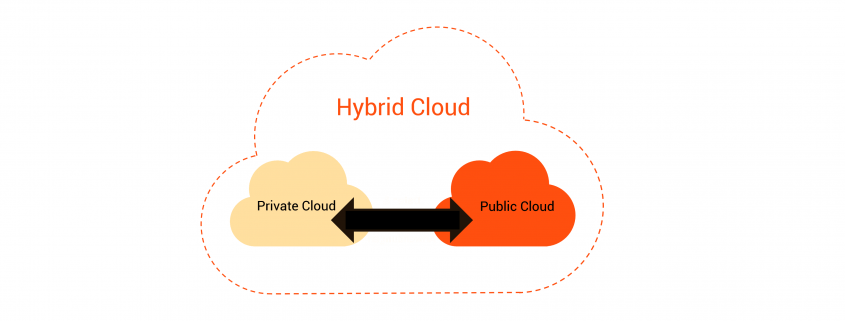The Cloud or Hybrid Cloud – Pros & Cons
Big data and artificial intelligence (AI) are some of today’s most disruptive technologies, and both rely on data storage. How organizations store and manage their digital information has a considerable impact on these tools’ efficacy. One increasingly popular solution is the hybrid cloud.
Cloud computing has become the norm across many organizations as the on-premise solutions struggle to meet modern demands for uptime and scalability. Within that movement, hybrid cloud setups have gained momentum, with 80% of cloud users taking this approach in 2022. Businesses noticing that trend and considering joining should carefully weigh the hybrid cloud’s pros and cons. Here’s a closer look.
The Cloud
To understand the advantages and disadvantages of hybrid cloud setups, organizations must contrast them against conventional cloud systems. These fall into two categories: public, where multiple clients share servers and resources, and private, where a single party uses dedicated cloud infrastructure. In either case, using a single cloud presents unique opportunities and challenges.
Advantages of the Cloud
The most prominent advantage of traditional cloud setups is their affordability. Because both public and private clouds entirely remove the need for on-premise infrastructure, users pay only for what they need. Considering how 31% of users unsatisfied with their network infrastructure cite insufficient budgets as the leading reason, that can be an important advantage.
The conventional cloud also offers high scalability thanks to its reduced hardware needs. It can also help prevent user errors like misconfiguration because third-party vendors manage much of the management side. Avoiding those mistakes makes it easier to use tools like big data and AI to their full potential.
Disadvantages of the Cloud
While outsourcing management and security workloads can be an advantage in some cases, it comes with risks, too. Most notably, single-cloud or single-type multi-cloud users must give up control and visibility. That poses functionality and regulatory concerns when using these services to train AI models or analyze big data.
Storing an entire organization’s data in just one system also makes it harder to implement a reliable backup system to prevent data loss in a breach. That may be too risky in a world where 96% of IT decision-makers have experienced at least one outage in the last three years.
Hybrid Cloud
The hybrid cloud combines public and private clouds so users can experience some of the benefits of both. In many instances, it also combines on-premise and cloud environments, letting businesses use both in a cohesive data ecosystem. Here’s a closer look at the hybrid cloud’s pros and cons.
Advantages of Hybrid Cloud
One of the biggest advantages of hybrid cloud setups is flexibility. Businesses can distribute workloads across public, private and on-premise infrastructure to maximize performance with different processes. That control and adaptability also let organizations use different systems for different data sets to meet the unique security needs of each.
While hybrid environments may be less affordable than traditional clouds because of their on-premise parts, they offer more cost-efficiency than purely on-prem solutions. Having multiple data storage technologies provides more disaster recovery options. With 75% of small businesses being unable to recover from a ransomware attack, that’s hard to ignore.
Hybrid cloud systems are also ideal for companies transitioning to the cloud from purely on-premise solutions. The mixture of both sides enables an easier, smoother and less costly shift than moving everything simultaneously.
Disadvantages of Hybrid Cloud
By contrast, the most prominent disadvantage of hybrid cloud setups is their complexity. Creating a system that works efficiently between public, private and on-prem setups is challenging, making these systems error-prone and difficult to manage. Misconfigurations are the biggest threat to cloud security, so that complexity can limit big data and AI’s safety.
Finding compatible public and private clouds to work with each other and on-prem infrastructure can also pose a challenge. Vendor lock-in could limit businesses’ options in this regard. Even when they get things working, they may lack transparency, making it difficult to engage in effective big data analytics.
Which Is the Best Option?
Given the advantages and disadvantages of hybrid cloud setups and their conventional counterparts, it’s clear that no single one emerges as the optimal solution for every situation. Instead, which is best depends on an organization’s specific needs.
The hybrid cloud is ideal for companies facing multiple security, regulatory or performance needs. If the business has varying data sets that must meet different regulations, some information that’s far more sensitive than others or has highly diverse workflows, they need the hybrid cloud’s flexibility and control. Companies that want to move slowly into the cloud may prefer these setups, too.
On the other hand, the conventional cloud is best for companies with tighter budgets, limited IT resources or a higher need for scalability. Smaller businesses with an aggressive digitization timeline, for example, may prefer a public multi-cloud setup over a hybrid solution.
Find the Optimal Data Storage Technology
To make the most of AI and big data, organizations must consider where they store the related data. For some companies, the hybrid cloud is the ideal solution, while for others, a more conventional setup is best. Making the right decision begins with understanding what each has to offer.





Leave a Reply
Want to join the discussion?Feel free to contribute!